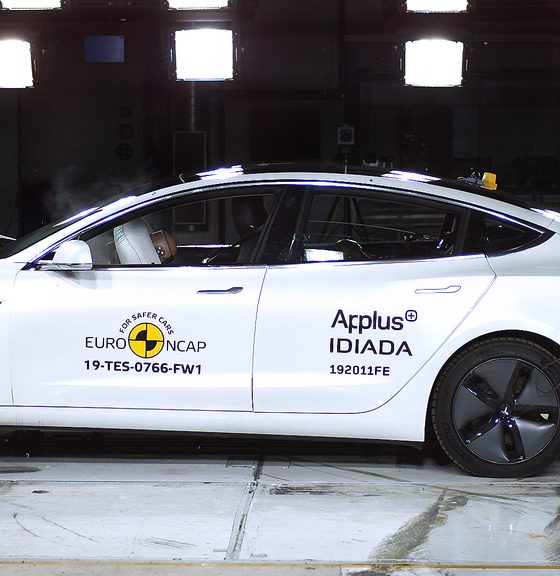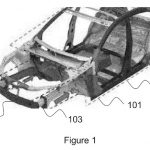

News
Tesla turns up vehicle safety with clever ‘crash can’ patent
Tesla’s electric cars are already among the safest vehicles on the road today with their impressive safety ratings. But even the best cars still have room for improvement, and one can count on Tesla to be the manufacturer that will do what it can to make its already-safe vehicles even safer. An example of this could be found in a recently published patent that describes a “crash can” that can help protect occupants better in the event of a collision.
The patent, titled “ADVANCED THIN-WALLED STRUCTURE FOR ENHANCED CRASH PERFORMANCE” describes a specific design for a “crash can,” a thin-walled metal structure that is built into the crash zones of a vehicle. These metal structures are built to absorb the energy of an impact, and are designed to deform in a stable manner during events such as a crash. Crash cans are typically a square, single-cell tube directly mounted to the front of the frame of the vehicle.
Tesla’s crash can patent takes the same concept but raises it up a couple of notches higher. Instead of using a simple square, single-cell tube, Tesla’s patent describes a “multi-cell structure that includes at least four hollow cuboids.” The four walls of the hollow cuboids meet at 90-degree angles and at least two of the cuboids share a wall. Tesla describes its design in the section below.
“In some embodiments a crash can for a vehicle includes a multi-cell structure that includes a hollow cuboid and four hollow isosceles trapezoidal prisms. The hollow cuboid has four walls and the four hollow isosceles trapezoidal prisms each have a long base, a short base, and two legs. The four hollow isosceles trapezoidal prisms are arranged around the hollow cuboid such that the long base of each hollow isosceles trapezoidal prism shares one of the walls of the hollow cuboid.”
- (Credit: US Patent Office)
- (Credit: US Patent Office)
Illustrations of Tesla’s “crash can” patent. (Credit: US Patent Office)
This updated design, while seemingly a minor change, actually improves the safety of a vehicle during a crash. According to Tesla, the crash can design in its recently-published patent provides a more stable deformation process. This increases the amount of energy that can be absorbed in a collision.
“One advantage of the various embodiments of the crash cans disclosed herein is that the multi-cell structure of the crash cans provides a more stable form of plastic deformation when the crash can is subject to the force of a collision relative to a single cell (tube) structure. Further, the various geometries described herein may further provide more stable plastic deformation relative to conventional geometries. As described herein, plastic deformation is the process of absorbing energy when the crash can is subject to a collision. Various exemplary crash cans provided herein increases plastic deformation, and thus the amount of energy absorbed, by increasing the probability that the crash cans buckle in a progressive manner. Thus, the multi-cell structure of the exemplary crash cans increases the probability that when subjected to axial force the crash cans will buckle in a stable top-down, progressive folding of the structure.
“Increasing plastic deformation in this manner grants the multi-cell crash can several advantages. For example, increasing plastic deformation in turn increases the amount of energy that will be absorbed during a collision, resulting in lower deceleration for the occupant(s) and critical components of a vehicle involved in a collision. This, in turn, results in an overall safer experience for the occupant(s) and critical components, providing for a lower chance of injury or damage. Additionally, increasing the probability that the multi-cell crash can buckles in a stable manner increases the predictability of how the crash can will react when subject to a collision, which in turn increases the predictability of how the rest of the vehicle will react. This allows for greater predictability of what an occupant will experience and allows for more precise planning on how to keep the occupant safe.”
The full text of Tesla’s novel “crash can” patent could be accessed here.
Among the carmakers in the auto segment today, Tesla is arguably the most obsessive when it comes to its vehicles’ safety. Each one of Tesla’s electric cars has performed well in crash tests, with the Model X SUV proving to be near-impossible to topple, and the Model 3 acing the safety tests of the NHTSA, Euro NCAP, ANCAP, and even the IIHS. With improvements such as those described in its recently-published “crash can” patent, Tesla’s electric cars today, as well as its upcoming vehicles, could prove even safer.

Elon Musk
Elon Musk’s X will start using a Tesla-like software update strategy
The initiative seems designed to accelerate updates to the social media platform, while maintaining maximum transparency.

Elon Musk’s social media platform X will adopt a Tesla-esque approach to software updates for its algorithm.
The initiative seems designed to accelerate updates to the social media platform, while maintaining maximum transparency.
X’s updates to its updates
As per Musk in a post on X, the social media company will be making a new algorithm to determine what organic and advertising posts are recommended to users. These updates would then be repeated every four weeks.
“We will make the new 𝕏 algorithm, including all code used to determine what organic and advertising posts are recommended to users, open source in 7 days. This will be repeated every 4 weeks, with comprehensive developer notes, to help you understand what changed,” Musk wrote in his post.
The initiative somewhat mirrors Tesla’s over-the-air update model, where vehicle software is regularly refined and pushed to users with detailed release notes. This should allow users to better understand the details of X’s every update and foster a healthy feedback loop for the social media platform.
xAI and X
X, formerly Twitter, has been acquired by Elon Musk’s artificial intelligence startup, xAI last year. Since then, xAI has seen a rapid rise in valuation. Following the company’s the company’s upsized $20 billion Series E funding round, estimates now suggest that xAI is worth tens about $230 to $235 billion. That’s several times larger than Tesla when Elon Musk received his controversial 2018 CEO Performance Award.
As per xAI, the Series E funding round attracted a diverse group of investors, including Valor Equity Partners, Stepstone Group, Fidelity Management & Research Company, Qatar Investment Authority, MGX, and Baron Capital Group, among others. Strategic partners NVIDIA and Cisco Investments also continued support for building the world’s largest GPU clusters.
News
Tesla FSD Supervised wins MotorTrend’s Best Driver Assistance Award
The decision marks a notable reversal for the publication from prior years, with judges citing major real-world improvements that pushed Tesla’s latest FSD software ahead of every competing ADAS system.

Tesla’s Full Self-Driving (Supervised) system has been named the best driver-assistance technology on the market, earning top honors at the 2026 MotorTrend Best Tech Awards.
The decision marks a notable reversal for the publication from prior years, with judges citing major real-world improvements that pushed Tesla’s latest FSD software ahead of every competing ADAS system. And it wasn’t even close.
MotorTrend reverses course
MotorTrend awarded Tesla FSD (Supervised) its 2026 Best Tech Driver Assistance title after extensive testing of the latest v14 software. The publication acknowledged that it had previously criticized earlier versions of FSD for erratic behavior and near-miss incidents, ultimately favoring rivals such as GM’s Super Cruise in earlier evaluations.
According to MotorTrend, the newest iteration of FSD resolved many of those shortcomings. Testers said v14 showed far smoother behavior in complex urban scenarios, including unprotected left turns, traffic circles, emergency vehicles, and dense city streets. While the system still requires constant driver supervision, judges concluded that no other advanced driver-assistance system currently matches its breadth of capability.
Unlike rival systems that rely on combinations of cameras, radar, lidar, and mapped highways, Tesla’s FSD operates using a camera-only approach and is capable of driving on city streets, rural roads, and freeways. MotorTrend stated that pure utility, the ability to handle nearly all road types, ultimately separated FSD from competitors like Ford BlueCruise, GM Super Cruise, and BMW’s Highway Assistant.
High cost and high capability
MotorTrend also addressed FSD’s pricing, which remains significantly higher than rival systems. Tesla currently charges $8,000 for a one-time purchase or $99 per month for a subscription, compared with far lower upfront and subscription costs from other automakers. The publication noted that the premium is justified given FSD’s unmatched scope and continuous software evolution.
Safety remained a central focus of the evaluation. While testers reported collision-free operation over thousands of miles, they noted ongoing concerns around FSD’s configurable driving modes, including options that allow aggressive driving and speeds beyond posted limits. MotorTrend emphasized that, like all Level 2 systems, FSD still depends on a fully attentive human driver at all times.
Despite those caveats, the publication concluded that Tesla’s rapid software progress fundamentally reshaped the competitive landscape. For drivers seeking the most capable hands-on driver-assistance system available today, MotorTrend concluded Tesla FSD (Supervised) now stands alone at the top.
News
Elon Musk’s Grokipedia surges to 5.6M articles, almost 79% of English Wikipedia
The explosive growth marks a major milestone for the AI-powered online encyclopedia, which was launched by Elon Musk’s xAI just months ago.

Elon Musk’s Grokipedia has grown to an impressive 5,615,201 articles as of today, closing in on 79% of the English Wikipedia’s current total of 7,119,376 articles.
The explosive growth marks a major milestone for the AI-powered online encyclopedia, which was launched by Elon Musk’s xAI just months ago. Needless to say, it would only be a matter of time before Grokipedia exceeds English Wikipedia in sheer volume.
Grokipedia’s rapid growth
xAI’s vision for Grokipedia emphasizes neutrality, while Grok’s reasoning capabilities allow for fast drafting and fact-checking. When Elon Musk announced the initiative in late September 2025, he noted that Grokipedia would be an improvement to Wikipedia because it would be designed to avoid bias.
At the time, Musk noted that Grokipedia “is a necessary step towards the xAI goal of understanding the Universe.”
Grokipedia was launched in late October, and while xAI was careful to list it only as Version 0.1 at the time, the online encyclopedia immediately earned praise. Wikipedia co-founder Larry Sanger highlighted the project’s innovative approach, noting how it leverages AI to fill knowledge gaps and enable rapid updates. Netizens also observed how Grokipedia tends to present articles in a more objective manner compared to Wikipedia, which is edited by humans.
Elon Musk’s ambitious plans
With 5,615,201 total articles, Grokipedia has now grown to almost 79% of English Wikipedia’s article base. This is incredibly quick, though Grokipedia remains text-only for now. xAI, for its part, has now updated the online encyclopedia’s iteration to v0.2.
Elon Musk has shared bold ideas for Grokipedia, including sending a record of the entire knowledge base to space as part of xAI’s mission to preserve and expand human understanding. At some point, Musk stated that Grokipedia will be renamed to Encyclopedia Galactica, and it will be sent to the cosmos.
“When Grokipedia is good enough (long way to go), we will change the name to Encyclopedia Galactica. It will be an open source distillation of all knowledge, including audio, images and video. Join xAI to help build the sci-fi version of the Library of Alexandria!” Musk wrote, adding in a later post that “Copies will be etched in stone and sent to the Moon, Mars and beyond. This time, it will not be lost.”










